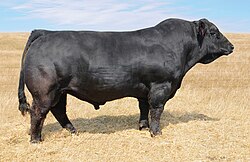History
European origin
Among the older and most widely distributed of all breeds of cattle in the world, and recorded since the Middle Ages, the Simmental breed has contributed to the creation of several other famous European breeds, including the Montbéliarde (France), the Pezzata Rossa d'Oropa (Italy), and the Fleckvieh (Germany and Austria).
Africa
Namibia (1893) and South Africa (1905) were the first countries outside Europe where the breed was successfully established. Here the breed is known as Simmentaler and is mainly used for beef cattle production under suckler cow systems. The Simmentaler breeders' society is, as far as registered animals are concerned, by far the largest of the 17 European and British breeds. The main reasons for its popularity are (i) it can be used with great success in crossbreeding for breeding of both cows with much milk and heavy weaners/oxen, (ii) its superb weight growth rate in feedlots - pure or crossed, and (iii) a strict visual inspection is compulsory for registration in the Herdbook. [1]
Soviet Union
In the former Soviet Union, the Simmental was the most important cattle breed. Russian Simmental (Симментальская корова) accounted for one-quarter of all cattle in the USSR. Through extensive crossbreeding, six strains were developed: [2]
In 1990, there were 12,849,800 Simmental in the USSR. In 2003, the Simmental count in Russia stood at 2,970,400. [2]
Types
No other breed in the world has such a large within-breed-type variation as Simmental-Fleckvieh which is classifiable in the following types:
- Dairy type like specialised dairy breeds (referring to Swiss Fleckvieh (code SF) with over 55% Red Holstein blood and the French Montebeliard breed);
- Dual purpose but major emphasis on milk;
- Truly dual-purpose (all cows are milked and bulls excel in weight gain);
- Moderate beef type (suckler, extensive ranching with moderate to small frame size);
- Extreme beef type (suckler, comparable to specialised beef breeds like for example Charolais, large frame size). [6]
The traditional colouration of the Simmental has been described variously as "red and white spotted" or "gold and white", although there is no specific standard colouration, and the dominant shade varies from a pale yellow-gold all the way to very dark red (the latter being particularly popular in the United States). The face is normally white, and this characteristic is usually passed to crossbred calves. The white face is genetically distinct from the white head of the Hereford.
This page is based on this
Wikipedia article Text is available under the
CC BY-SA 4.0 license; additional terms may apply.
Images, videos and audio are available under their respective licenses.



